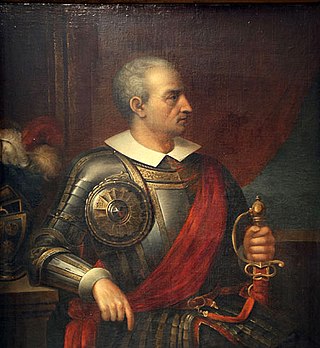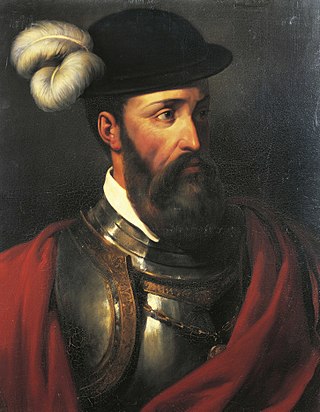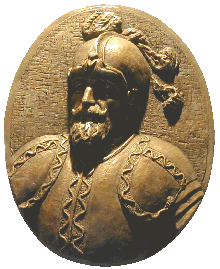
Diego de Almagro, also known as El Adelantado and El Viejo, was a Spanish conquistador known for his exploits in western South America. He participated with Francisco Pizarro in the Spanish conquest of Peru. While subduing the Inca Empire he laid the foundation for Quito and Trujillo as Spanish cities in present-day Ecuador and Peru respectively. From Peru, Almagro led the first Spanish military expedition to central Chile. Back in Peru, a longstanding conflict with Pizarro over the control of the former Inca capital of Cuzco erupted into a civil war between the two bands of conquistadores. In the battle of Las Salinas in 1538, Almagro was defeated by the Pizarro brothers and months later he was executed.

Francisco Pizarro, Marquess of the Atabillos was a Spanish conquistador, best known for his expeditions that led to the Spanish conquest of the Inca Empire.

Gonzalo Pizarro y Alonso was a Spanish conquistador. He was the younger paternal half brother of Francisco Pizarro, who led the Spanish conquest of the Inca Empire. Pizarro was the illegitimate son of Gonzalo Pizarro y Rodríguez de Aguilar (1446–1522), who, as an infantry colonel, served under Gonzalo Fernández de Córdoba during the Italian Wars. He was also the younger paternal half brother of Hernándo Pizarro y de Vargas and the older paternal full brother of Juan Pizarro y Alonso.

Manco Inca Yupanqui was the founder and monarch of the independent Neo-Inca State in Vilcabamba, although he was originally a puppet Inca Emperor installed by the Spaniards. He was also known as "Manco II" and "Manco Cápac II". He was one of the sons of Huayna Capac and a younger brother of Huascar.
Juan Pizarro y Alonso was a Spanish conquistador who accompanied his brothers Francisco, Gonzalo and Hernando Pizarro for the conquest of Peru in 1532.
The Battle of Las Salinas was a military conflict and decisive confrontation between the forces of Hernando and Gonzalo Pizarro against those of rival conquistador Diego de Almagro, on April 6, 1538, during the Conquest of Peru. Both camps claimed to represent the authority of the Spanish Crown; Pizarro's forces controlled the province of Nueva Castilla, and those of Almagro, Nueva Toledo.

Hernando Pizarro y de Vargas was a Spanish conquistador and one of the Pizarro brothers who ruled over Peru.

Alonso de Alvarado Montaya González de Cevallos y Miranda (1500–1556) was a Spanish conquistador and knight of the Order of Santiago.
Francisco Pizarro (c. 1471–1541) was a Spanish conquistador who led an expedition that conquered the Inca Empire.

Francisco de Aguirre was a Spanish conquistador who participated in the conquest of Peru, Bolivia, Chile and Argentina.
Pedro Pizarro was a Spanish chronicler and conquistador. He took part in most events of the Spanish conquest of Peru and wrote an extensive chronicle of them under the title Relación del descubrimiento y conquista de los reinos del Perú, which he finished in 1571.
Gonzalo Pizarro y Rodríguez de Aguilar (1446–1522) was a Spanish Captain from the region of Extremadura who participated in several campaigns in Italy and Navarre. He is most famed for fathering the four Pizarro brothers, Francisco, Hernando, Gonzalo and Juan, who conquered the Inca Empire.

The Battle of Jaquijahuana was fought between the forces of Gonzalo Pizarro and Pedro de la Gasca, on April 9, 1548, during the Revolt of the Encomenderos by the Spanish conquistadores.
After his unheard claims as governor of New Castile (Peru) following the death of his brother, Gonzalo Pizarro pressed claims to be recognized as the ruler of the land he and his brothers had conquered. After the arrival of appointed royal viceroy Blasco Núñez Vela in 1544, Gonzalo succeeded to have him repelled and sent to Panama in chains. He was released, however, and returned to Peru by sea while Gonzalo was mustering an army. The two met on January 18 at Iñaquito in the outskirts of Quito, present-day capital of Ecuador, where the superiority of the Nueva Castilla army ensured victory for Gonzalo. Blasco Núñez Vela reportedly fought but fell as a victim in battle and was later decapitated on the field of defeat, a fate Gonzalo himself would share two years later at Jaquijahuana.

Juan Jufré de Loayza y Montesa (1516–1578) was a Spanish conquistador who participated in the 1541 expedition of Pedro de Valdivia to Chile. He was the first alcalde of Santiago, Chile and held the position of governor of the Argentine province of Cuyo. He founded the city of San Juan de la Frontera and re-founded the city of Mendoza.

Quispe Sisa, also known as Inés Huaylas Yupanqui, was an Inca princess, daughter of the Sapa Inca Huayna Capac. She played a role in the Spanish conquest of the Inca Empire. The Palace of the Conquest in Trujillo, Spain features busts of her, her daughter Francisca Pizarro Yupanqui, Francisco Pizarro and her daughter's husband, Hernando Pizarro.

Alonso de Mendoza was a Spanish captain, conquistador, and the founder of the city of Nuestra Señora de La Paz. He was appointed by Pedro de la Gasca, the "Peacemaker," to found the city to commemorate the peace in the Peruvian colonies after the defeat of the Pizarro brothers.
Sebastián Garcilaso de la Vega y Vargas was a Spanish conquistador and colonial official. He fathered a son, the mestizo chronicler Garcilaso de la Vega, with the Inca princess Isabel Chimpu Occlo.

The history of Cusco (Peru), the historical capital of the Incas.











